Darrell Brooks trial: Week 1 recap, state calls 8 witnesses
Darrell Brooks trial: Judge doing 'extraordinary job,' expert says
Witness testimony resumes Monday morning in the Darrell Brooks trial, charged in the November 2021 Waukesha Christmas parade attack. This, after an eventful first week of the trial that saw repeated disruptions from the defendant, prompting him to be moved from the main courtroom every day, starting moments after jury selection began.
WAUKESHA, Wis. - Witness testimony resumes Monday morning, Oct. 10 in the Darrell Brooks trial, charged in the November 2021 Waukesha Christmas parade attack. This, after an eventful first week of the trial that saw repeated disruptions from the defendant, prompting him to be moved from the main courtroom every day, starting moments after jury selection began.
MONDAY: Jury selection
Jury selection was supposed to begin at 8:30 a.m. Monday, Oct. 3, but five minutes in, Brooks was returned to his holding cell. By mid-morning, Brooks was removed from the main courtroom and taken to an adjacent courtroom due to multiple interruptions. He was moved back and forth throughout the afternoon. As of about 2:30 p.m., he would remain in the adjacent courtroom for the rest of the day.
In court Monday, Brooks made "sovereign citizen arguments," telling the court he did not recognize the name Darrell Brooks and asking Judge Jennifer Dorow for certified copies of her oath. He also rambled about the Constitution and asked the judge repeatedly for her name. Brooks filed handwritten paperwork Monday morning asking that, among other things, prosecutors provide "verified proof" that Brooks is a United States citizen.

Darrell Brooks in court for jury selection Monday, Oct. 3
He told the judge he had been "bombarded with paperwork" after the judge on Sept. 28 allowed him to defend himself, and Brooks fired his attorneys. The defendant argued his lack of time to review the material was like "going into a gunfight with a butter knife."
The judge called Brooks' "sovereign citizen" declaration an "obstructionist tactic" to not acknowledge the jurisdiction of the court.
Brooks made the following requests in court Monday morning: For standby counsel, an adjournment of the case, for Dorow to state her name in court and for more time to review the discovery documentation he received on Friday. There was testimony on Brooks' ability to have access to the documentation and to a computer to prepare for the start of the trial Monday. All of his requests were denied by the judge.
SIGN UP TODAY: Get daily headlines, breaking news emails from FOX6 News
Seven of the first 41 jurors were stricken for cause; 60+ others were on standby but not questioned Monday. They would go through the process Tuesday.
The court went into recess around 6:30 p.m. Monday.
TUESDAY: Jury selection, Day 2
Tuesday began much as Monday did. The jury selection process was expected to resume at 8:45 a.m., but almost immediately, there were disruptions and delays from Brooks, picking up right where we left off on Monday. Brooks was again moved to a separate courtroom for the voir dire. Brooks was moved back and forth throughout the day once again.
Brooks again asked the judge for her name and whether she had a claim against him, asking to adjourn the case. This was denied.

Darrell Brooks in court for jury selection Tuesday, Oct. 4
Ten prospective jurors were released Tuesday morning.
At one point, Brooks ripped up a jury chart he was given and threw it in the trash.
Six jurors were stricken before lunch.
On Tuesday afternoon, Brooks, from the adjacent courtroom, claimed to have hearing trouble and was given a headset to use.
Two more potential jurors were stricken after lunch, and by late Tuesday afternoon, the peremptory strike process was underway. This, after Brooks' motion to strike the entire jury panel was denied by the judge.

Darrell Brooks trial, jury selection, peremptory strike process
Brooks initially refused to participate in the peremptory strike process, crossing off the names of all potential jurors instead of one at a time (alternating with the state). The clerk had to use a tumbler to draw the names of random jurors to be stricken on Brooks' behalf. He declined eight out of the 10 peremptory strikes. He did make two of his peremptory strikes.
Before this, Brooks asked to call the State of Wisconsin to the stand, and the judge informed him he cannot call an entity to the stand; he must call a person. He also moved to dismiss the case again.
At least three times Tuesday, Brooks refused to return to the main courtroom from the adjacent courtroom when given the opportunity. At one point, Brooks told the judge to "remove me," adding: "I told you that before I even came over here. It was pointless for me to come over here."
By 6:30 p.m., all 16 jurors selected for the panel had been sworn in; 10 men and six women, all white.
WEDNESDAY: Housekeeping matters, COVID claims
The jury was not present for Wednesday afternoon's hearing to discuss final housekeeping matters before opening statements Thursday.
Brooks appeared in his orange jail uniform after appearing in a suit and tie Monday and Tuesday.
Brooks told the court he believed he had COVID and needed to wait until at least Friday for test results to come back. He sought an adjournment due to being in COVID protocol.
"I’ve had people close to me who have passed away from COVID – I’m frightened," Brooks told the court.
Brooks was offered a rapid test and refused, asking, "Why would I need to take two tests for the same thing?"
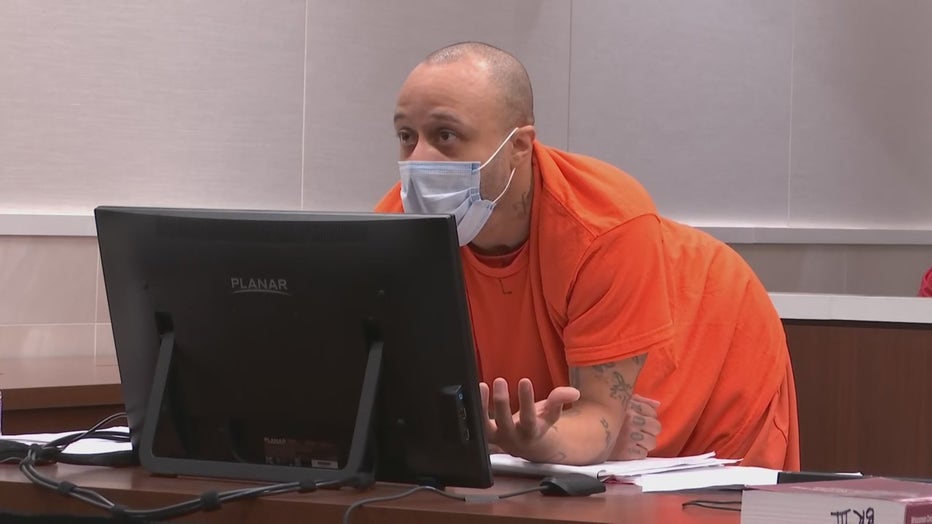
Darrell Brooks in court Wednesday, Oct. 5
Prosecutors said he's heard on jail phone calls telling his mother he's going to delay the trial. The judge agreed with the prosecution, calling Brooks' COVID adjournment request "nothing more than a delay tactic." In denying Brooks' motion to adjourn, the judge said if he was truly concerned about his health and safety, he would take the COVID rapid test he was offered and refused. The Waukesha County Jail administrator testified even if Brooks did have COVID, they would be able to safely produce him for court.
When the court finally got to addressing the housekeeping issues, the judge ruled prosecutors would be able to ask about Brooks' prior convictions dating back to 1999. The prosecutor noted 12, including three in Nevada.
Late Wednesday afternoon, the judge laid out the procedure for objections, with the judge telling Brooks he could use his objection sign in the adjacent courtroom, and the judge and prosecution noting that Brooks would forfeit his right to cross-examine witnesses if he did not act civilly.
"You represent yourself at your own peril," said Judge Dorow.
The court also finalized the 68 pages of jury instructions, with one page added regarding decorum and courtesy in the courtroom.
Brooks said he didn't accept or consent to the amended jury instructions as the paperwork was placed in front of him by a bailiff. He said he wanted to draft a written jury instruction, and Dorow said he could submit that by Thursday morning for her review.

Darrell Brooks in court Wednesday, Oct. 5
The court then discussed exhibits, and Waukesha County District Attorney Sue Opper noted that the state filed eight pages of 140 exhibits, a combination of videos, photos and documents. She noted the document was provided to Brooks, though he declined to accept it.
The prosecutor asked if all exhibits could be added to one thumb drive and that could be entered into the court record. Brooks held up his objection sign.
Brooks said most of his exhibits will be paperwork. Dorow said if he has something specific, he should let the state know, so they can make arrangements to assist in displaying it to a witness, if appropriate.
Opper renewed her offer to assist Brooks in helping serve subpoenas for him, so long as they are relevant witnesses for this case in southeastern Wisconsin.
THURSDAY: Opening statements, prosecution calls first two witnesses
The day started Thursday morning much like the prior three did with interruptions from Brooks. Ten hours later, the judge complimented Brooks, and the defendant thanked the judge for her comments.
Within moments of the proceedings getting underway Thursday at 8:30 a.m., Brooks interrupted Judge Dorow multiple times.
The judge attempted to get through final court procedures before bringing in the jury for jury instructions before the opening statements and could not do so because of Brooks' interruptions. She indicated if Brooks did not stop the interruptions, he would be removed from court.
"This is Day 4, and every day, he has interrupted and resulted in him being placed in a nearby courtroom," said Judge Dorow.
On Thursday morning, Brooks refused to change into a suit and tie, telling the court, "There's no possible way that people will not know I am in custody."

Darrell Brooks in court Thursday, Oct. 6
Before 9 a.m., Brooks was moved to the adjacent courtroom, seen on camera shirtless. Dorow said a report would be filed with the sheriff's office after Brooks took off his shoe and threatened to throw things.
Brooks claimed to have suffered a cut to his finger and a bruise to his arm during his removal from court. The judge said Brooks would see jail medical staff during the lunch break.
Following Brooks' continued disruptive behavior, Opper noted "complete confidence" in Brooks' competency. Dorow agreed, saying Brooks' behavior was intended to "make a mockery of the court," adding that he was examined as recently as July and August and there were no competency concerns.
Before the jury was brought in, the judge denied the state's motion for reconsideration regarding showing witnesses' faces on the trial broadcast with the exception of minor witnesses.

Darrell Brooks objects during the reading of jury instructions Thursday, Oct. 6
By mid-morning, preliminary jury instructions were being read to the court; a lengthy process as the judge had to lay out all 76 counts against Brooks. During jury instructions, Brooks was seen in the adjacent courtroom holding up his objection sign; at one point, putting it down the front of his pants.
After lunch, Brooks asked to return to the main courtroom and was moved, but interrupted the court again before preliminary jury instructions continued. Before 3 p.m., he was back in the adjacent courtroom. Before the prosecution's opening statement began, Brooks was non-responsive when asked if he wanted to come back.
At one point during Thursday's proceedings, Brooks commented on his moving back and forth between courtrooms. Brooks told the court he was being "rushed to judgment by moving me," noting that he "has a right to be present during these proceedings." He said he "merely" wants clarification on things.
"I don't understand what is going on," said Brooks. "It's not to be disrespectful."
Most of Brooks' issues Thursday related to wanting to have his objections made during jury instructions discussed at the present time, and his "sovereign citizen" claims continued. Opper argued the "sovereign citizen" defense has no conceivable validity in American law. Judge Dorow denied all related "sovereign citizen" filings. Dorow said she would be using the name on the official charging documents related to this case: Darrell Brooks.
Before 3 p.m., Brooks told the court he recognized one of the jurors from his initial appearance, saying, "She flipped me off. I don't want that to end up being an issue."
Darrell Brooks trial: Defendant tells the court he recognizes one of the jurors
Darrell Brooks told Judge Jennifer Dorow on Oct. 6 that he recognized one of the jurors picked for the case from a previous incident. Here is that exchange.
The judge reminded Brooks that he had an opportunity to make 10 peremptory strikes. Brooks said he could only see the judge and the prosecutors' table from the adjacent courtroom during the voir dire.
"There was no way for me to see who the jury was," said Brooks. "Obviously, I wouldn't know them by name."
Dorow later said this issue was checked on, and it was confirmed by this juror she did not attend any proceedings in this case.
With jurors set to be brought back in for opening statements, Dorow offered Brooks the opportunity to move back into the main courtroom.
"You want me to come over there just to get brought back over here?" Brooks asked.
He was again reminded of the need to follow court decorum.
Brooks argued he "cannot put on an adequate defense if I don't understand."
"Forgive me for being this way, but if I don't understand, I'm going to ask questions," said Brooks. "You haven't answered anything I've asked you, and I have to answer everything you've asked me. I just want it to be fair."
Brooks said he's "not asking for legal advice."
The judge reminded Brooks again that he waived his right to an attorney, and they were not going to discuss these issues in the middle of a trial.
Darrell Brooks trial: Prosecution opening statement (part 1)
Darrell Brooks trial: Prosecution opening statement (part 1)
Zachary Wittchow delivered the opening statement for the state.
"The events started off normal. There were dance teams, high school marching bands, local businesses all making their way down the parade route," said Wittchow. "The streets were lined with friends and family members and neighbors; people there to soak up the atmosphere. Kids ran into the street to pick up candy. It sounds corny, but I think you’ll see from the videos, there was a sense of joy in the air. Darrell Brooks killed that joy. He replaced it with terror…and death."
"He hit the gas with his red Ford Escape and used it as a battering ram over and over again, striking men, women and kids. In the end, Mr. Brooks killed six people. He injured dozens more and left a permanent scar on this community," Wittchow continued.
Wittchow talked about the events that led to the Christmas parade attack, including the fight at Frame Park where Brooks is accused of punching his ex-girlfriend in the face. From there, Wittchow said he "pulled off," eventually plowing through the parade route. Wittchow also laid out the witnesses the state planned to call and the groups in the parade impacted by Brooks' actions.
Darrell Brooks trial: Prosecution opening statement (part 2)
The prosecution team in the Darrell Brooks trial finished up its opening statement -- making way for the start of the trial. Brooks has opted to defer his opening statement until he begins his defense.
Brooks deferred his opening statement until a later point in the trial.
After their opening statement, the state called its first two witnesses -- Waukesha Police Sgt. David Wanner and Kori Runkel, Brooks' ex-girlfriend's roommate.
Sgt. Wanner talked about the parade route, where police were located, where barricades were located, what time officers arrived and things that were done to ensure the parade route was secure.
He said he saw Brooks' red SUV speeding toward him and tried to get the driver's attention. He estimated he was six feet away from the SUV, which passed in front of him. He said the driver was in a "dazed, straight focus ahead" position. He said the driver didn't respond, passing him and entering the parade route.
When asked what he did, Wanner said he was bombarded with… "the most terrible thing I ever heard" over the police radio.

Waukesha Police Sgt. Dave Wanner emotional as he testifies in Darrell Brooks' trial Oct. 6
During cross-examination, Brooks asked Wanner if he could see in the video people being targeted or in a panic to get away from the SUV. Wanner said no. Brooks asked if Wanner saw the driver intentionally try to hit anyone. Wanner said no. Brooks asked if Wanner was brought to testify on behalf of the plaintiff. An objection by the state was sustained. Brooks asked Wanner if he could see the plaintiff (the state) in court. Objections by the state were sustained.
The state's second witness was Kori Runkel, Brooks' ex-girlfriend's roommate. She went into more detail about the Frame Park fight that preceded the Christmas parade attack. She said at one point, Brooks tried to run his ex over, and Runkel said she and Brooks "ended up going at it." Video of the fight was shown in court.
On cross-examination, Brooks asked Runkel how she would know the SUV belonged to Brooks if she had never seen Brooks before that day. He also tried to call her credibility into question by asking her about the alcohol she said she consumed that day. He also questioned Runkel about a statement she gave to police. Prosecutors brought up the fact that this statement was actually a statement written by the police after Runkel gave her statement to them. Therefore, the police report was a summary of Runkel's statement vs. her verbatim statement. Brooks questioned Runkel about what was in the statement vs. what she testified to in court. Brooks also questioned Runkel about whether what she saw in the video that was played could be defined as a "brawl" between Runkel and Brooks.
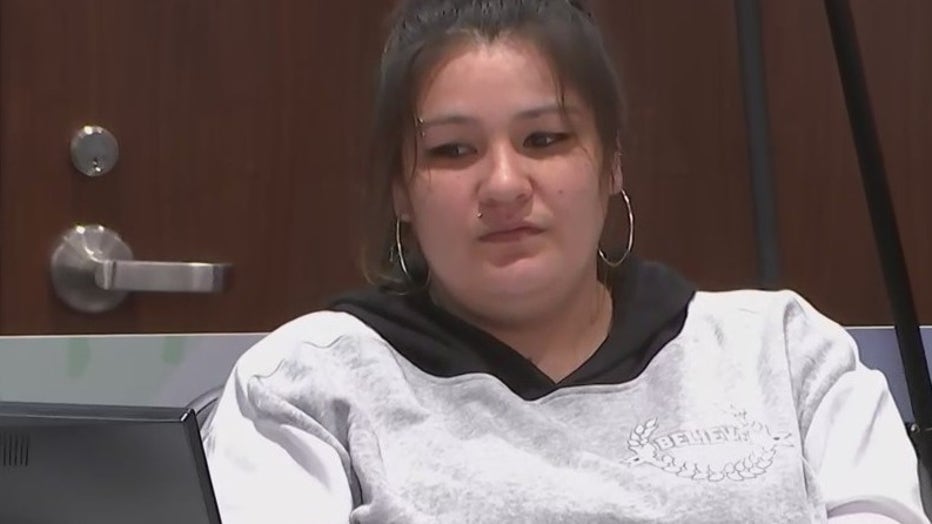
Darrell Brooks cross-examines Kori Runkel Oct. 6
As testimony went into the evening, Brooks asked to come back to the main courtroom and was moved.
At one point, Judge Dorow told Brooks he was doing a "good job" asking questions and added that she was "happy he decided to come back" to the main courtroom.
After a short redirect by Wittchow, testimony concluded for the night around 6:30 p.m. Wittchow clarified what Runkel told police and asked Runkel to identify who she "chested up" to during the fight. She pointed at Brooks.
After the jury left, Judge Dorow commended Brooks for returning to the courtroom and complying with the process, pointing out he did unmask when needed. She said he asked some cogent questions that sometimes went relevantly toward the witness.
"You might not always ask the best questions, but you make some relevant points," said Dorow.
She encouraged him to keep prepping.
"I really appreciate that you came back over and that you’ve been following the rules," said Dorow.
"Thank you for giving me the chance to come back in. I appreciate what you said," said Brooks.
The court adjourned for the night around 6:40 p.m.
FRIDAY: First full day of testimony, Brooks' COVID test negative
Friday was the first full day of testimony, and Brooks remained in the main courtroom most of Friday. He again wore his orange jail uniform.
After calling two to the stand Thursday, prosecutors called six additional people to testify Friday.
Erika Patterson, Brooks' ex-girlfriend, was the first to testify. She testified she met Brooks when she was 15, that they had been together "off and on" over the years and that they have a teenage daughter together.
Patterson's testimony focused on the Frame Park fight before the Christmas parade attack. Patterson said Brooks hit her in the eye, and she jumped out of Brooks' SUV, walking to Frame Park. Brooks followed, and at Frame Park, fought with Runkel. A friend then called the police.
Darrell Brooks cross-examines ex-girlfriend, Erika Patterson
Darrell Brooks cross-examined his ex-girlfriend, Erika Patterson, during his trial on Friday, Oct. 7.
It led to an unusual set-up for cross-examination as Brooks represents himself.
"First of all, good morning and happy birthday," he said.
Brooks' cross-examination included questions about The Women's Center, where Patterson lives, and past altercations.
Brooks: "If the conversation was argumentative, why would you meet up with the alleged defendant?"
Patterson: "I don't know."
Later, Brooks asked about abuse: "At any time did you report any abuse?"
Patterson: "Yes, that you hit me."
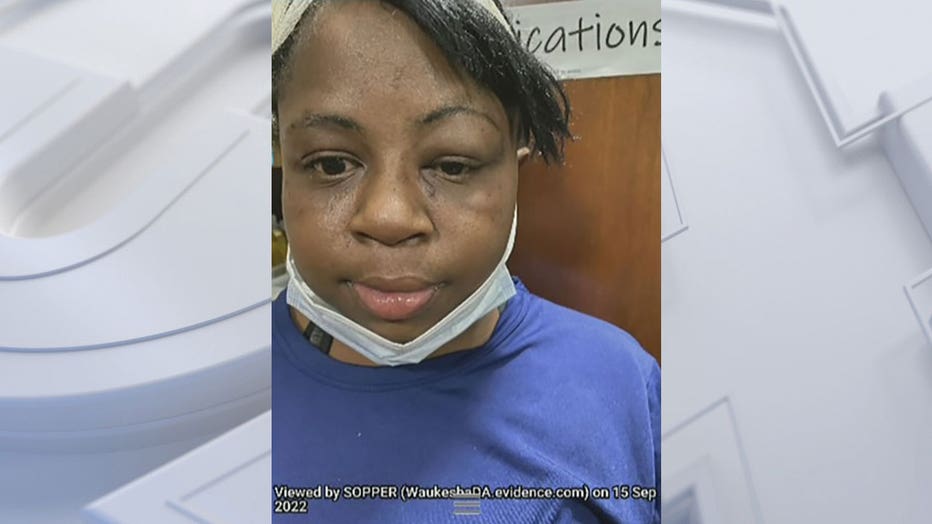
Erika Patterson
The cross-examination became heated, Patterson growing tired of what she considered to be answering the same questions from Brooks.
Waukesha Police Detective Steven Guth was the second to testify. He testified about his interaction with Patterson after she appeared to have been struck in the face, saying she was "extremely afraid of Mr. Brooks."
Brooks was given an opportunity to cross-examine Guth, but that line of questioning was ended after the judge repeatedly sustained objections brought by the prosecution.
Shortly before the lunch break, Brooks refused to provide his COVID test results to the court. The judge noted there was an "altercation" with the bailiffs when getting the test results envelope. It was eventually determined Brooks was negative for COVID. He was placed in the adjacent courtroom before the lunch recess.
After lunch, Brooks had his head down and a Bible on his desk. He later appeared to be crying.
"I’m just a little emotional right now," Brooks told the judge. He reached for a tissue and began writing a letter to her.
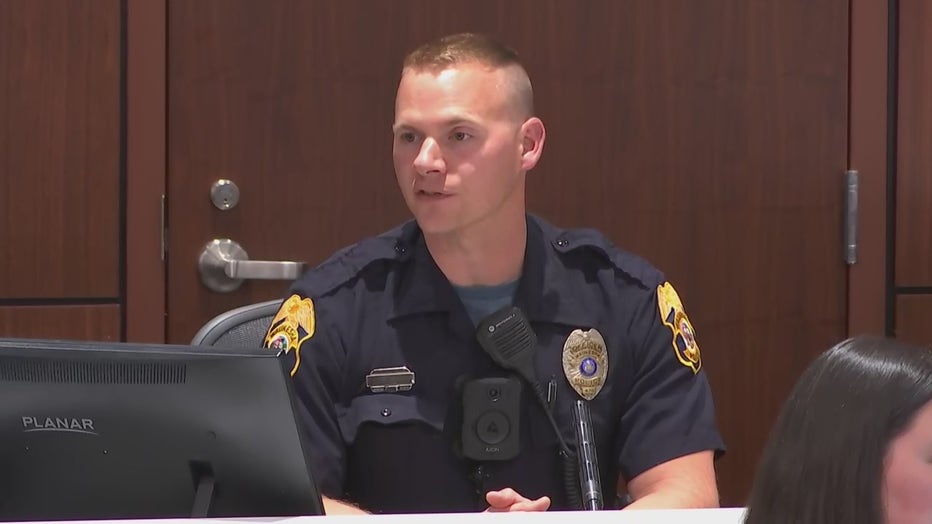
Jeremy Philipps, Waukesha Police Department
Waukesha Police Officer Jeremy Philipps then testified. He talked about how he was dispatched to Frame Park for the fight between Brooks, Patterson and Runkel.
Philipps testified he was with Patterson, taking her statement, when he heard someone had been hit downtown and "all available units" were called. He said he left Patterson and the others and responded to the scene of the parade attack.
"It was just mass chaos, carnage everywhere," said Philipps.
Philipps said a parent told him a "red SUV sped through the parade and did this."
"I knew from the radio calls it was Darrell Brooks," Philipps testified.
During his cross-examination, Brooks asked Philipps if he would normally be on duty at the time of Friday's testimony and if he was being paid to testify. Philipps said he would normally be on duty.
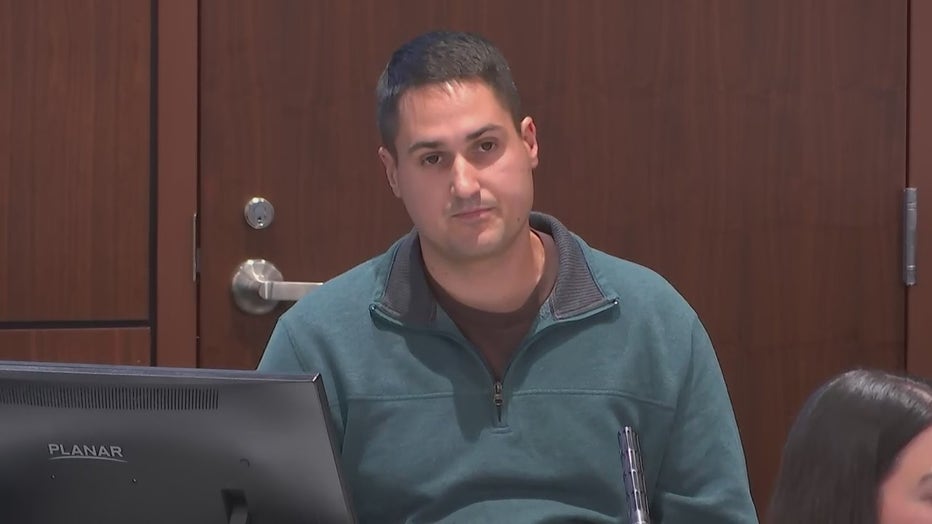
Kyle Edwards, attended Waukesha Christmas parade with his wife and two children
Kyle Edwards testified he was at the Waukesha Christmas Parade with his wife and two children on the day the red SUV drove through the parade route, striking dozens of people.
He said he saw the red SUV going the wrong way, and it stopped next to his vehicle. He said the driver threw his hands up in the air, stuck his head out of the window and said he needed gas. Edwards identified the driver as Brooks. He said there was a "direct view" in front of him of the SUV going through the parade.
Holly Berg told the court she was dropping her boyfriend's daughter off at the parade. Berg provided a graphic description of what happened at the parade when the red SUV plowed through the crowd, striking a community group.
Opper: "Did you see the red SUV strike any people in the Catholic community group?"
Berg: "Several."
Opper: "Can you estimate how many?"
Berg: "At least 15."
Opper: "I'm sorry to ask it this way, but did you see anybody, like, actually, fly or roll or tumble?"
Berg: "So originally it was, I heard sounds, like, thuds, and then it was in the air, like, bowling pins."
Berg also estimated the red SUV was traveling about 20 mph when it was going through the downtown area.
Opper: "Did you ever see the vehicle stop?"
Berg: "I think it did slow down…I remember the brake lights, and it continued."
Opper: "Did you see it drive over people?"
Berg: "I saw there was just chaos in the street."
Holly Berg testifies for the state in the Darrell Brooks trial
Holly Berg testified for the state in the Darrell Brooks trial, providing a description of a red SUV plowing through crowds of people at the Waukesha Christmas Parade.
Waukesha Police Detective Thomas Casey was the last to testify Friday. The jury was shown a photograph that Casey testified showed Brooks driving his red SUV through the parade route. Opper asked Casey if he was "100% sure" it was Brooks; Casey answered "1,000 (percent)."
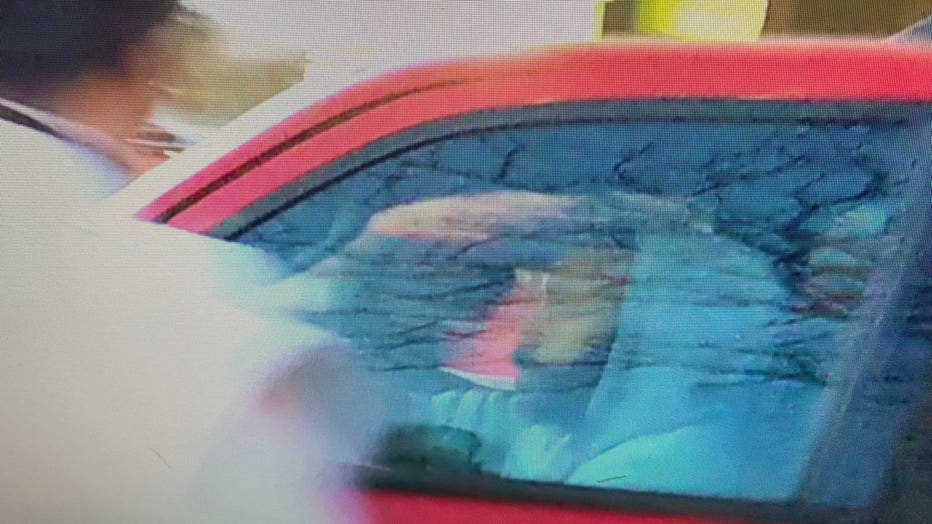
Photo shown in court Friday, Oct. 7 allegedly showing Darrell Brooks driving the red Ford Escape
The detective also showed drone video taken along Main Street, the parade route, showing where each of the six victims who died was hit. He said there were eight "units" of the parade impacted, including the Milwaukee Dancing Grannies, the Waukesha Blazers youth baseball team and the Waukesha South High School marching band.
"I would say at least three different groups of spectators on the side of the road were also injured," said Casey. He noted, in total, police identified 60 people who were injured.
Casey also said he tried to stop the red SUV.

Det. Thomas Casey, Waukesha Police Department
"I thought it was just a lost motorist," Casey said. "Not often, but sometimes, people come through impatient. They always stop. I'm yelling, 'Stop,’ pounding on the hood (of the SUV), trying to get the person's attention so they'd stop. The vehicle kept pushing, struck right through me."
After a long week for the jury, both sides agreed to stop testimony roughly one hour early Friday, around 4:30 p.m.
The trial is scheduled to resume Monday at 8:30 a.m. At that time, Judge Dorow ordered Brooks to have his witness list ready.
The judge said she would also revisit dashcam video that was shown in court Friday because, in that video, Brooks said he was able to hear the mother of his child discussing a prior case that the judge had previously ruled inadmissible.

